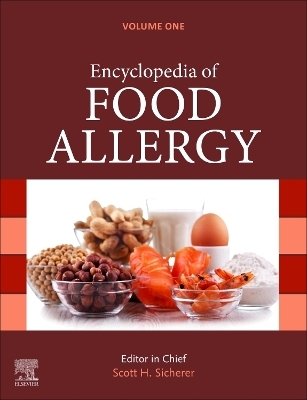
Encyclopedia of Food Allergy
Elsevier - Health Sciences Division
978-0-323-96018-2 (ISBN)
Scott H. Sicherer, M.D., is the Elliot and Roslyn Jaffe professor of allergy, immunology and pediatrics at the Icahn School of Medicine at Mount Sinai and the Director of the Jaffe Food Allergy Institute. He is Chief of the Division of Pediatric Allergy and Immunology, and Medical Director of the Institution’s Clinical Research Unit. Sicherer received his medical degree from the Johns Hopkins University School of Medicine. He is board-certified in allergy and immunology and specializes in food allergies. His research interests include gastrointestinal manifestations, epidemiology, psychosocial and quality of life issues, diagnostics, prevention, genetics and treatments. He has published over 275 articles and 75 book chapters in major pediatric and allergy textbooks and journals, and has been consistently recognized as among the top 1% of researchers in his field.
Immunologic Sciences -Mucosal immunity -Tolerance -Immunology of IgE mediated allergy -Immunology of non-IgE mediated allergy -B cell compartment -T cell compartment -Effector cells -Antigen presenting cells -Route of senstization -Mouse models -In vitro studies -Genetics of FA -Microbiome -Systems biology to understand food allergy Food sciences applicable to allergy (allergens, additives, toxins, measurement/detection) -Molecular characteristics of food allergens -Nomenclature food allergens -Review of allergens Egg Milk Grains Soy and legumes Peanut Tree nuts Fish Shellfish Sesame and seeds Fruit allergy Vegetable allergy Cross reactivity Meat allergies (note alpha gal is covered under disease states) Allergy to protein additives/colors (carmine, pectin, gelatin, etc) -Genetic engineering -Thresholds -Labeling food allergens-studies -Labelling food allergens-laws -Allergen detection systems -Food additives and preservatives (multiple chapters with allergic implication -Sulfites -MSG -Tartrazine, azo/non-azo dyes, -Antioxidants, -Benzoates, parabens, -Colorings, flavorings, -Natural protein-based additives -Food toxins -Pharmacologic reactions to foods
Definitions, epidemiology, economics, quality of life, psychosocial impact Food allergy definitions and overview (IgE, non-IgE, mixed] Food intolerance (break down types) Common food allergens and food groups/clinical implications and cross-reactivity Food allergy pediatric versus adult epidemiology Natural course of food allergy Tools for epidemiologic determination of food allergy Epidemiology of food allergy, prevalence Food allergy risk factors Economics Disparities Quality of life (QOL) QOL instruments Anxiety Bullying (not management)
Disease states of IgE mediated allergy Atopic Dermatitis [diagnosis, management, role of food] Pollen-food related syndrome [overview, relationships, management] Urticaria/angioedema Respiratory tract Oral allergy syndrome/pollen-food allergy syndrome Food Induced Anaphylaxis Food associated exercise-induced anaphylaxis Alpha-gal allergy
Disease states of non-IgE mediated/mixed pathophysiology gastrointestinal allergy *each state likely needs sub-topics [15-20 chapters] Food protein induced enterocolitis syndrome [definitions, diagnosis, management, natural course] Food protein induced proctocolitis Eosinophilic esophagitis Eosinophilic gastritis Eosinophilic colitis Eosinophilic gastroenteritis Intolerance and other adverse reactions to foods Overview Lactose intolerance Hereditary/metabolic disorders Alcohol dehydrogenase deficiency Celiac disease Role of food: colic, constipation Role of food: IBS, IBD Mast cell disorders and food allergy Autism/developmental disorders and foods Headaches and neurological issues and foods Rheumatologic diagnoses and foods Skin responses not related to atopic dermatitis or urticarial (FFE, physical urticarial) Primary immunodeficiency with implications for food allergy Asthma and food additives
Diagnostics General approach (history, physical, prior probability assessment, test selection) Natural course related to diagnostics Skin tests Serum IgE with whole proteins Component tests Diagnostics with regard to cross-reactivity Epitope testing BAT MAT Elimination diets Oral food challenges (multiple) Incorporating history and testing Novel testing/monitoring Unproven methods Management [15-20 chapters] Nutrition topics (multiple and by ages), including daily management Occupational food allergy QOL/anxiety/bullying Age differences in management [infant/child/teen-young adult/adult] Restaurants School Anaphylaxis plans Label reading Home management Vaccine and medication allergies related to food allergies Lay organizations and general resources for food allergy Prevention Overview of current recommendations (global) Role of maternal diet Role of breastfeeding Role of infant formula Early diet Microbiome/prebiotics/probiotics/synbiotics Skin barrier Diet diversity Nutrients, vitamin D Novel methods for primary and secondary prevention
Therapeutic approaches Overview Oral immunotherapy [overview/approach/safety-efficacy others] Sublingual immunotherapy Immunotherapies with modified proteins or DNA vaccines Adjuvants Biologics-proteins Small molecule therapeutics Shared decision making for therapeutics Quality of life and therapeutics
| Erscheint lt. Verlag | 9.7.2024 |
|---|---|
| Mitarbeit |
Chef-Herausgeber: Scott H Sicherer |
| Verlagsort | Philadelphia |
| Sprache | englisch |
| Maße | 216 x 276 mm |
| Gewicht | 450 g |
| Themenwelt | Medizin / Pharmazie ► Medizinische Fachgebiete ► Mikrobiologie / Infektologie / Reisemedizin |
| Technik ► Lebensmitteltechnologie | |
| ISBN-10 | 0-323-96018-9 / 0323960189 |
| ISBN-13 | 978-0-323-96018-2 / 9780323960182 |
| Zustand | Neuware |
| Haben Sie eine Frage zum Produkt? |